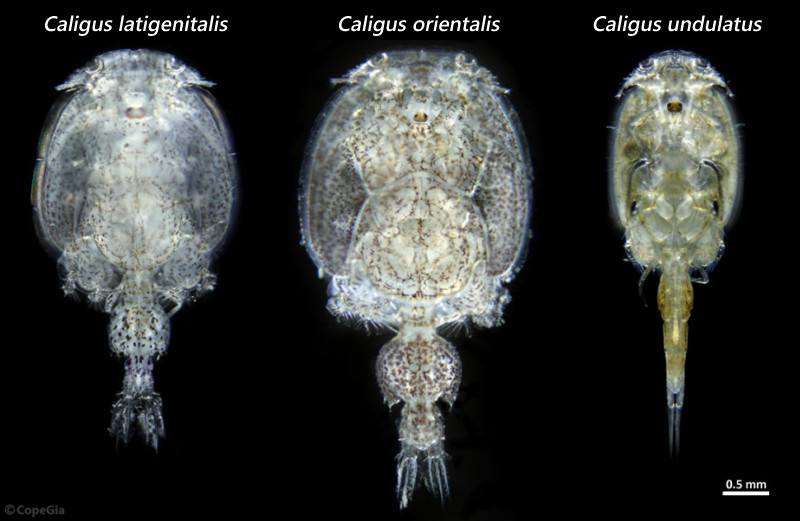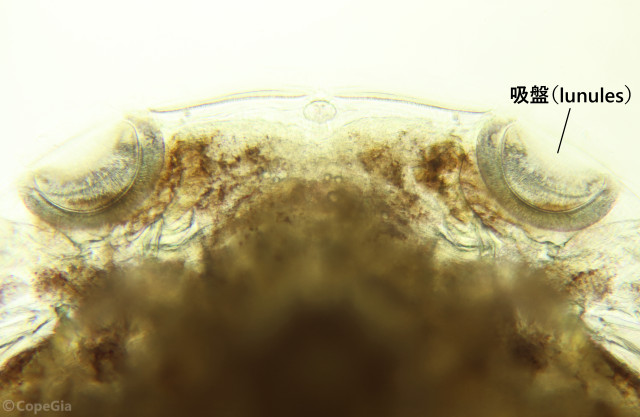東京湾に浮遊するウオジラミ、寄生性カイアシ類 魚から脱離した個体
ウオジラミという魚類に寄生するカイアシ類がいます。Poecilostomatoida(目)、Caligidae(ウオジラミ科)に分類される5 mm程度の甲殻類です。頭胸部全体が吸盤のような仕組みで魚の体表などに吸着して寄生します。一方で、魚に寄生していたウオジラミが脱離して、プランクトンとして水柱を浮遊する個体もいます。
筆者は2021年8月28日と2021年9月25日に、葛西臨海公園(東京)にてライトトラップによる夜間採集をしました。両日とも満潮後の引き潮時です。塩分は10‰程度で隣接する荒川からの淡水が多く混入していた模様です。
採集したウオジラミは、Caligus latigenitalis Shiino, 1954、Caligus orientalis Gusev, 1951、Caligus undulatus Shen & Li, 1959の3種と同定しました(Fig. 1)。数はC. undulatusが一番多く、懐中電灯で照らせる2平方メートルあたり、多いときで10個体以上いました。C. latigenitalisは1個体、C. orientalisは2個体で、プランクトンとしてあまり採れない種のようです。このことはC. undulatusが頻繁に浮遊するという知見(VenmathiMaran et.al. 2012b)と一致します。これら、種の同定については次回以降に解説したいと思います。
筆者調べで、プランクトンとして採れたという報告があるウオジラミは21種のようです(Ho & Lin 2004a; VenmathiMaran & Ohtsuka 2008; VenmathiMaran et.al. 2012a; VenmathiMaran et.al. 2012b)。そのうち、日本に出現する11種を以下にあげます。
- ・Caligus calotomi
- ・Caligus coryphaenae
- ・Caligus latigenitalis
- ・Caligus longiramus
- ・Caligus macarovi
- ・Caligus ogawai
- ・Caligus orientalis
- ・Caligus productus
- ・Caligus punctatus
- ・Caligus undulatus
- ・Caligus sclerotinosus
今回、採れたウオジラミ3種、C. latigenitalis、C. orientalis、C. undulatusも報告にありました。
ウオジラミの浮遊は、何らかで宿主から脱離した、事故的なものだと考えられていました(Kabata 1979)。しかし、実際はそういうわけではないようです。ウオジラミは脱皮で成長のステージが変わり、7回脱皮することで成体になります(Ohtsuka et.al. 2009)。浮遊するのは、8つあるステージのうち最終脱皮後の成体のみです。Haywardら(2011)はウオジラミの1種C. chiastosに寄生されたミナミマグロ(Thunnus maccoyii)には成体しか寄生されておらず、成体の前の成長ステージでは他の複数種の魚類に寄生していたのを発見しました。成体になったら、最終的な宿主を探しに浮遊をするようです。これは成体の脚に備える浮遊に適した羽状刺毛をもつことからも示唆されます。一方で、成体前のステージ、カリムス期でも、ごく稀に浮遊します。カリムス期は頭部先端の前額糸(フィラメント)でしっかりと寄生するはずなので、事故的に宿主から脱離した個体だと考えられています(Ho & Lin 2004b)。
VenmathiMaran & Ohtsuka(2008)はウオジラミが宿主から脱離して浮遊する要因を4つあげています。
- 1. 宿主が外傷を負ったり病気により弱ったとき
- 2. 宿主の切り替え
- 3. 生活様式の変化
- 4. 偶発的な脱離
とくに浮遊するのは雄が8割のようです。雌は卵を抱卵するため、常に宿主から栄養をとらないといけないため浮遊しにくいとのことです。
浮遊するウオジラミはCaligus属ばかりです。他属ではほとんど浮遊しません(VenmathiMaran et.al. 2012b)。Caligus属は、頭部先端に対の吸盤(lunules)(Fig. 2)をもっているのが特徴です。この吸盤は進化的に新しい分類群がもっており(Boxshall & Justine 2005)、頭胸部全体の吸着の働きを補助し、効率的に宿主への寄生を可能にするようです(Kaji et.al. 2012)。Caligus属がよく浮遊するのは、吸盤をもつことで浮遊後に再び寄生できないリスクを低めるからなのかもしれません。
文 献
Boxshall GA, Justine J-L (2005) A new genus of parasitic copepod (Siphonostomatoida: Caligidae) from the razorback scabbardfish, Assurger anzac (Trichidae) off New Caledonia. Folia Parasitol., 52: 349-358.
Hayward CJ Svane I, Lachimpadi SK, Itoh N, Bott NJ, Nowak BF (2011) Sea lice infections of wild fishs near ranched southern bluefin fish tuna (Thunnus maccoyii) in South Australia. Aquaculture (Amsterdam, Netherlands), 320: 178-182.
Ho J-S, Lin CL (2004a) Caligus planktonis Pillai (Copepoda, Siphonostomatoida) parasitic on the Largescale mullet of Taiwan. Crustaceana 76 (10): 1201-1209.
Ho J-S, Lin CL (2004b) Sea Lice of Taiwan (Copepoda: Siphonostomatoida: Caligidae). The Sueichan Press, Taiwan. 388 pp.
Kabata Z (1979) Parasitic Copepoda of British Fishes. The Ray Society, London. 468 pp.
Kaji T, VenmathiMaran BA, Kondoh Y, Ohtsuka S, Boxshall BA, Tsukagoshi A (2012) The lunule of caligid copepods: an evolutionarily novel structure. Evol. Dev., 14 (6): 465-475.
VenmathiMaran BA, Ohtsuka S (2008) Descriptions of caligiform copepods in plankton samples collected from East Asia: Accidental occurrences or a new mode of life cycle? Plankton. Benthos Res., 3 (4): 202-215.
VenmathiMaran BA, Ohtsuka S, Jitchum P (2012) Occurrence of caligid copepods (Crustacea) in plankton samples collected from Japan and Thailand, with the descriotion of a new species. Species Divers. 17: 87-95.
VenmathiMaran BA, Ohtsuka S, Shang X (2012) Records of adult caligiform copepods (Crustacea: Copepoda: Siphonostomatoida) in marine plankton from East Asia, including descriptions of two new species of Caligus (Caligidae). Species Divers., 17: 201-219.


